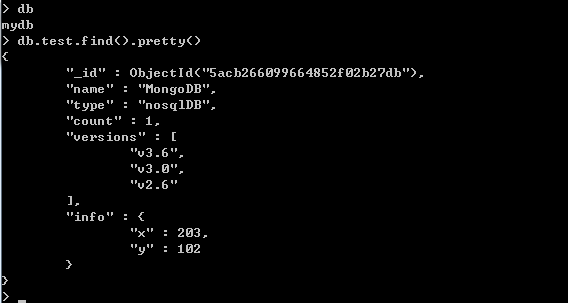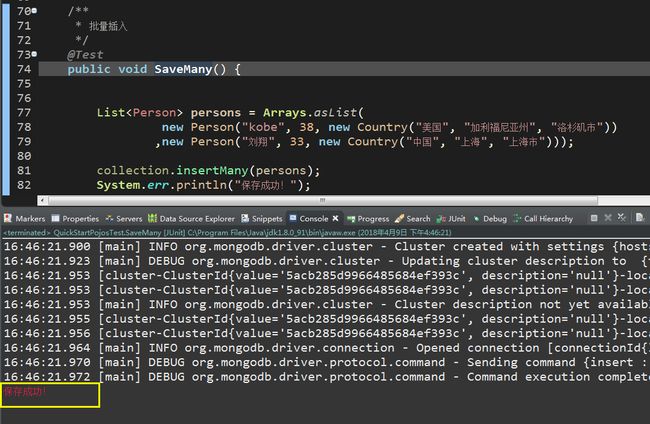Java + 原生MongoDB驱动 API 使用案例详说(两种方式)
前不久,博主利用spring-boot结合spring-data-mongodb包,搞了一把mongodb的集成 -- 增删改查
这种方式,比较固执,使用起来虽然方便,但是太依赖spring,我想创建自己的dbname,都无从下手(可能我还没探究到),只能使用配置文件里面一开始就默认的url
很烦,我不知道我要创建数据库A、B、C.....什么的,要怎么做? 而且查询也非常繁琐,so,本篇打算用原生的MongoDB API进行mongodb的使用,不难,看了后,就可以举一反三了,好了,我们开始吧!
一、pom依赖
注:由于博主习惯使用Spring-Boot框架写demo,因此,下面贴出来的pom符合Spring-Boot的依赖规范,但是,明眼人一眼就可以看出MongoDB API 用到的两个依赖是什么
pom.xml
4.0.0
com.appleyk
Spring-Boot-MongoAPI
0.0.1-SNAPSHOT
MongoDB-API
使用Java原生MongoDB_API进行数据的存储和访问
org.springframework.boot
spring-boot-starter-parent
1.5.9.RELEASE
1.8
3.6.3
org.springframework.boot
spring-boot-starter-web
org.springframework.boot
spring-boot-starter-test
test
junit
junit
org.springframework.boot
spring-boot-devtools
true
org.mongodb
mongo-java-driver
${mongodb.version}
org.mongodb
bson
${mongodb.version}
注意两个地方
1、版本一定要统一,否则,出现未知的异常(比如说:‘’为什么我的数据保存不上,博主你的却可以呢? ”)我可不管
2、关键的两个依赖包
下面开始,只贴代码,说明都在注释里面了,希望需要的朋友对照自己的项目进行拷贝改造,别往运行看效果!!!
二、API使用快速入门 ☞ Document对象
QuickStartTest.java
import static com.mongodb.client.model.Filters.*;
import static com.mongodb.client.model.Updates.*;
import java.util.Arrays;
import java.util.HashMap;
import java.util.Map;
import org.bson.Document;
import org.junit.Test;
import com.mongodb.MongoClient;
import com.mongodb.client.MongoCollection;
import com.mongodb.client.MongoCursor;
import com.mongodb.client.MongoDatabase;
import com.mongodb.client.result.DeleteResult;
import com.mongodb.client.result.UpdateResult;
public class QuickStartTest {
MongoClient mongoClient = new MongoClient("localhost" , 27017);
//或者使用下面的方法,使用连接字符串进行构建Mongo客户端实例
// MongoClientURI connectionString = new MongoClientURI("mongodb://localhost:27017");
// MongoClient mongoClient = new MongoClient(connectionString);
/**
* 一旦有了连接到MongoDB部署的MongoClient实例,就可以使用MongoClient.getdatabase()方法来访问数据库。
* 将数据库的名称指定到getDatabase()方法。如果数据库不存在,MongoDB将在您第一次为该数据库存储数据时创建数据库
* 数据库实例不可变
*/
MongoDatabase database = mongoClient.getDatabase("mydb");
/**
*
* 一旦有了DB实例后,就使用它的getCollection()方法来访问一个集合。
* 将集合的名称指定到getCollection()方法。如果一个集合不存在,MongoDB将在您第一次为该集合存储数据时创建集合。
*/
/**
* 例如,使用数据库实例,下面的语句访问mydb数据库中的名为test的集合
* 集合不可变
*/
MongoCollection collection = database.getCollection("test");
/**
* 存入一条数据【插入一个文档对象】
*/
@Test
public void SaveOne(){
/**
* 有了DB实例、Collection集合后,就该存储文档(数据)了
* 要使用Java驱动程序创建文档,请使用Document(文档)类 --org.bson.Document
* 要使用Java驱动程序创建文档,实例化一个具有字段和值的文档对象
* new Document(Map) 或者 new Document(key,value)
* 并使用其append()方法将其他字段和值包含到文档对象中
* 该值可以是另一个文档对象,以指定嵌入的文档
*/
/**
* 数据(含文档套文档) :
{
"name" : "MongoDB",
"type" : "nosqlDB",
"count" : 1,
"versions": [ "v3.6", "v3.0", "v2.6" ],
"info" : { x : 203, y : 102 }
}
*/
Map map = new HashMap<>();
map.put("x", 203);
map.put("y", 102);
Document document = new Document("name","MongoDB")
.append("type", "nosqlDB")
.append("count", 1)
.append("versions", Arrays.asList("v3.6","v3.0","v2.6"))
.append("info", new Document(map));
/**
* 有了文档对象后,就是向集合collection中保存了
* 也可以批量插入List,方法为collection.insertMany(documents);
*/
collection.insertOne(document);
/**
* 要计算集合中的文档数,可以使用集合的count()方法。
*/
System.err.println("count of documents from collection is :"+collection.count());
}
/**
* 无条件取出(查询)第一个文档对象(第一条数据)
*/
@Test
public void findOne(){
Document doc = collection.find().first();
System.err.println("只取【test】集合中的第一个文档对象:"+doc.toJson());
}
/**
* 无条件取出(查询)所有的文档对象(所有数据)
*/
@Test
public void findAll(){
/**
* 要检索集合中的所有文档,我们将使用find()方法,而不需要任何参数。
* 为了遍历结果,将iterator()方法链接到find()中。
* 迭代器类似SQL的游标cursor
*/
MongoCursor cursor = collection.find().iterator();
try {
/**
* 如果迭代到下一个对象等于false,退出迭代,并关闭迭代器
*/
int index = 0;
while (cursor.hasNext()) {
System.err.println((index+1)+":"+cursor.next().toJson());
index++;
}
} finally {
cursor.close();
}
System.err.println("=======不推荐下面的遍历法");
/**
* 虽然可以允许迭代使用下面的习惯用法,但避免使用它,因为如果循环提前终止,应用程序可能会泄漏一个游标:
*/
for (Document cur : collection.find()) {
System.err.println(cur.toJson());
}
}
/**
* 带条件查询文档对象
*/
@Test
public void queryOne(){
/**
* 要查询匹配某些条件的文档,请将filter对象传递给find()方法。
* 为了方便创建过滤器对象,Mongo-Java驱动程序提供了过滤器帮助器。
*/
/**
* 查询count == 1 的文档对象
*/
Document doc = collection.find(eq("count", 1)).first();
if(doc!=null){
System.err.println("条件1查询结果:"+doc.toJson());
}else{
System.err.println("条件1查询结果:无");
}
/**
* 查询count<2 且 name.equals("Mongo")的文档对象,显然不存在
* 如果查询全部符合条件的文档集合,请使用find(*).iterator()
*/
doc = collection.find(and(lt("count",2),eq("name", "Mongo"))).first();
if(doc!=null){
System.err.println("条件2查询结果:"+doc.toJson());
}else{
System.err.println("条件2查询结果:无");
}
/**
* Filters
* gt gte === > >=
* lt lte === < <=
* eq === ==
* and === 相当于 sql语句的 where xxx and xxx
* or === 相当于 sql语句的 where xxx or xxx
*/
}
/**
* 更新文档 -- ByOne
*/
@Test
public void updateOne(){
/**
* 要更新集合中的文档,使用集合的updateOne方法更新单个文档对象
*
* $set 相当于 sql语句的 update collection set type = "database" where name = "MongoDB" limit 1
*/
UpdateResult result = collection.updateOne(eq("name", "MongoDB"), new Document("$set", new Document("type", "database")));
System.err.println("更新影响的行数:"+result.getModifiedCount());
}
/**
* 批量更新文档 -- ByMany
*/
@Test
public void updateMany(){
/**
* 要更新集合中的文档,使用集合的updateMany方法更新所有符合条件的文档对象
* 下面更新所有name等于"MongoDB"的文档对象的count属性 +100
*/
UpdateResult result = collection.updateMany(eq("name", "MongoDB"), inc("count", 100));
System.err.println("更新影响的行数:"+result.getModifiedCount());
}
/**
* 删除文档 -- ByOne
*/
@Test
public void deleteOne(){
/**
* 删除第一个type.equals("nosqlDB")的文档对象
*/
DeleteResult result = collection.deleteOne(eq("type", "nosqlDB"));
System.err.println("删除影响的行数:"+result.getDeletedCount());
}
/**
* 批量删除文档 -- ByMany
*/
@Test
public void deleteMany(){
/**
* 删除所有count>=100的文档对象
*/
DeleteResult result = collection.deleteMany(gte("count", 100));
System.err.println("删除影响的行数:"+result.getDeletedCount());
}
} 注意一个地方
Mongo查询和更新的过滤器,需要引入这两个静态包,别忘啦(除非你拷贝了整个demo)
来几个测试效果图
1、保存单条文档
查询
2、按条件查询
其余不在演示
三、API使用快速入门 ☞ Pojos对象
Country.java
public final class Country {
private String name;
private String province;
private String city;
public Country() {
}
public Country(String name , String pro, String city) {
this.name = name ;
this.province = pro;
this.city = city;
}
public String getName() {
return name;
}
public void setName(String name) {
this.name = name;
}
public String getProvince() {
return province;
}
public void setProvince(String province) {
this.province = province;
}
public String getCity() {
return city;
}
public void setCity(String city) {
this.city = city;
}
}
Person.java
import org.bson.types.ObjectId;
public final class Person {
/**
* MongoDB自动分配的ID
*/
private ObjectId id;
private String name;
private int age;
private Country country;
public Person() {
}
public Person(String name , int age,Country country){
this.name = name ;
this.age = age ;
this.country = country;
}
public ObjectId getId() {
return id;
}
public void setId(final ObjectId id) {
this.id = id;
}
public String getName() {
return name;
}
public void setName(final String name) {
this.name = name;
}
public int getAge() {
return age;
}
public void setAge(final int age) {
this.age = age;
}
public Country getCountry() {
return country;
}
public void setCountry(Country country) {
this.country = country;
}
@Override
public String toString(){
return "name:"+name+",age:"+age+",国家:"+country.getName()+",省/州:"
+country.getProvince()+",市:"+country.getCity();
}
}再来个测试用例类
QuickStartPojosTest.java
import static org.bson.codecs.configuration.CodecRegistries.fromProviders;
import static org.bson.codecs.configuration.CodecRegistries.fromRegistries;
import static com.mongodb.client.model.Filters.*;
import java.util.Arrays;
import java.util.List;
import org.bson.codecs.configuration.CodecProvider;
import org.bson.codecs.configuration.CodecRegistry;
import org.bson.codecs.pojo.PojoCodecProvider;
import org.junit.Test;
import com.appleyk.entity.Country;
import com.appleyk.entity.Person;
import com.mongodb.MongoClient;
import com.mongodb.client.MongoCollection;
import com.mongodb.client.MongoDatabase;
public class QuickStartPojosTest {
/**
* 在使用驱动程序使用POJO之前,您需要配置CodecRegistry以包含一个codecs来处理从bson到POJO的转换
* 要做到这一点,最简单的方法是使用PojoCodecProvider.builder()来创建和配置一个CodecProvider
* 下面的示例将合并默认的codec注册表,并将PojoCodecProvider配置为自动创建PojoCodecs
*/
CodecProvider pojoCodecProvider = PojoCodecProvider.builder().automatic(true).build();
CodecRegistry pojoCodecRegistry = fromRegistries(MongoClient.getDefaultCodecRegistry(),
fromProviders(pojoCodecProvider));
/**
* 设置pojoCodecRegistry的方法有多种 可以在实例化MongoClient对象时设置它
* 1.MongoClient mongoClient = new MongoClient("localhost", MongoClientOptions.builder().codecRegistry(pojoCodecRegistry).build());
* 也可以在创建database的时候使用它
* 2.database = database.withCodecRegistry(pojoCodecRegistry);
* 3.也可以在使用集合的时候使用它
* collection = collection.withCodecRegistry(pojoCodecRegistry);
*/
/**
* 客户端实例不可变
*/
MongoClient mongoClient = new MongoClient("localhost", 27017);
/**
* 数据库实例不可变
*/
MongoDatabase database = mongoClient.getDatabase("mydb").withCodecRegistry(pojoCodecRegistry);
/**
* 集合不可变
*/
MongoCollection collection = database.getCollection("people", Person.class);
/**
* 插入单个Person实体对象
*/
@Test
public void SaveOne() {
Person person = new Person("appleyk", 20, new Country("中国", "河南省", "郑州市"));
collection.insertOne(person);
System.err.println("保存成功!");
}
/**
* 批量插入
*/
@Test
public void SaveMany() {
List persons = Arrays.asList(
new Person("kobe", 38, new Country("美国", "加利福尼亚州", "洛杉矶市"))
,new Person("刘翔", 33, new Country("中国", "上海", "上海市")));
collection.insertMany(persons);
System.err.println("保存成功!");
}
/**
* 查询集合中的第一个pojo对象 === pojos的查询 等同于 documents的查询
*/
@Test
public void findOne(){
Person person = collection.find().first();
System.err.println(person);
}
/**
* 根据过滤条件进行单个Person实体对象的查询
*/
@Test
public void queryOne(){
Person person = collection.find(eq("name","kobe")).first();
System.err.println(person);
}
/**
* ..............此处省略100行代码,自己补充
*/
} 同理,注意一个地方 --- 静态包的手动引入
效果演示
1、保存多条
其余不再演示
有问题请留言
喜欢的给个赞
------------------------------------------------学习使人快乐!











